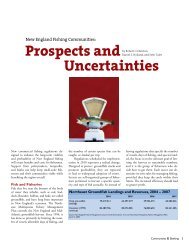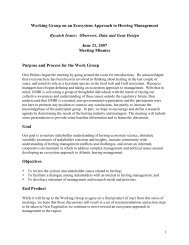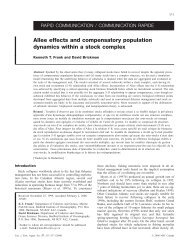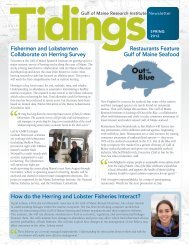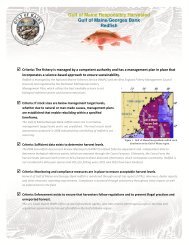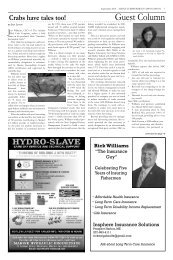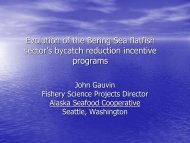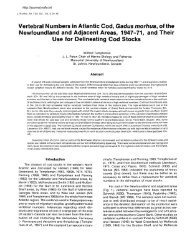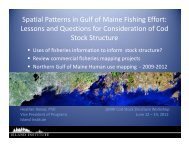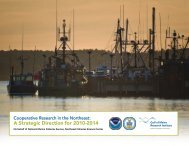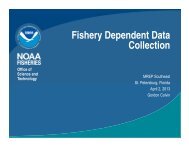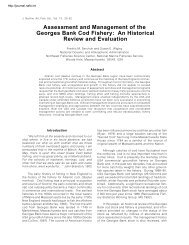Community-based Sectors for the New England Groundfish Fishery
Community-based Sectors for the New England Groundfish Fishery
Community-based Sectors for the New England Groundfish Fishery
You also want an ePaper? Increase the reach of your titles
YUMPU automatically turns print PDFs into web optimized ePapers that Google loves.
somewhat vague on how <strong>the</strong> allocations <strong>for</strong> future sectors would be calculated, at least <strong>for</strong><br />
allocations of stocks o<strong>the</strong>r than GB cod. The common presumption was that that allocations will<br />
be a percentage of <strong>the</strong> TAC calculated by dividing <strong>the</strong> sector vessels’ accumulated landings over<br />
<strong>the</strong> five years fishing years prior to submitting <strong>the</strong>ir proposal by <strong>the</strong> total documented<br />
(presumably commercial) landings <strong>for</strong> that stock over <strong>the</strong> same period. This would mean that, <strong>for</strong><br />
a sector submitting its proposal in May of 2007 with plans to begin operation in May of 2008, its<br />
allocation would be <strong>based</strong> on catches in <strong>the</strong> fishing years beginning in 2002-2006. This<br />
allocation <strong>for</strong>mula is likely to change anyway as a result of amendment 16.<br />
The regulations that implemented sectors require sectors to submit a proposal accompanied by an<br />
environmental assessment that satisfies National Environmental Policy Act (NEPA) and o<strong>the</strong>r<br />
requirements <strong>for</strong> regulatory analysis of fishery management actions. The initial allocation of<br />
catch or DAS to <strong>the</strong> sector would require authorization by <strong>the</strong> Council through a framework or<br />
amendment. After <strong>the</strong> initial authorization, <strong>the</strong> sector would be required to submit an operations<br />
plan and a binding contract to <strong>the</strong> NMFS Regional Administrator (RA) along with an updated EA<br />
that evaluates <strong>the</strong> operations plan. The RA <strong>the</strong>n reviews <strong>the</strong> operations plan and seeks public<br />
comment on it be<strong>for</strong>e giving <strong>the</strong> final approval (through a federal rule making) required <strong>for</strong> <strong>the</strong><br />
sector to operate. Submission to and approval by <strong>the</strong> RA of an operations plan and contract with<br />
an updated EA is required each year <strong>the</strong> sector continues to operate, but fur<strong>the</strong>r Council actions<br />
are not required <strong>for</strong> annual authorization of <strong>the</strong> sector unless <strong>the</strong>re are substantial changes to <strong>the</strong><br />
operations plan or membership.<br />
Sector management offers a number of potential advantages over <strong>the</strong> current management system.<br />
By accepting hard limits on total allowable catch (TAC) on all species, <strong>the</strong> regulations suggest<br />
that <strong>the</strong> sector members may be able to exempt <strong>the</strong>mselves from trip limits and a number of<br />
existing management controls including trip limits, seasonal closures and overall limits on days at<br />
sea (DAS). This offers sector members an opportunity to:<br />
• increase efficiency by increasing flexibility of when and where <strong>the</strong>y fish;<br />
• manage fishing operations to meet social as well economic objectives of <strong>the</strong> sector;<br />
• concentrate on increasing quality and value of fish caught without concern <strong>for</strong> lost fishing<br />
time;<br />
• make targeting and location decisions without concern <strong>for</strong> lost fishing time;<br />
• avoid having to return to port or discard fish because a trip limit is reached <strong>for</strong> one species<br />
(this “regulatory discarding” is currently a legal practice but leads to <strong>the</strong> discarding and<br />
mortality of large amounts of marketable fish);<br />
• transfer and potentially consolidate catch privileges between sector members to reduce capital<br />
costs.<br />
The potential benefits of sectors go beyond allowing more effective and efficient use of catch<br />
allocations. They empower fishery stakeholder to develop innovative ways to better manage <strong>the</strong><br />
resources <strong>the</strong>y have access to, and <strong>the</strong>y can create strong incentives <strong>for</strong> <strong>the</strong>se stakeholder to<br />
conserve fishery resources since <strong>the</strong>ir catch allocations in future years are directly related to <strong>the</strong><br />
size and productivity of <strong>the</strong> fish stocks. <strong>Sectors</strong> may also offer an opportunity <strong>for</strong> communities<br />
that have historically participated in <strong>the</strong> groundfish fishery to maintain <strong>the</strong> viability of <strong>the</strong>ir local<br />
fishing fleets, preserve or regain access to <strong>the</strong> fishery, and become actively involved in managing<br />
local fishery resources through creation of community owned permit banks. By purchasing<br />
permits and associated catch history, a community entity could own a share of a sector’s catch<br />
allocation and make it available to sector members as an incentive to retain vessels in <strong>the</strong><br />
community. Such a permit bank might also provide a means <strong>for</strong> communities to provide ongoing<br />
11



